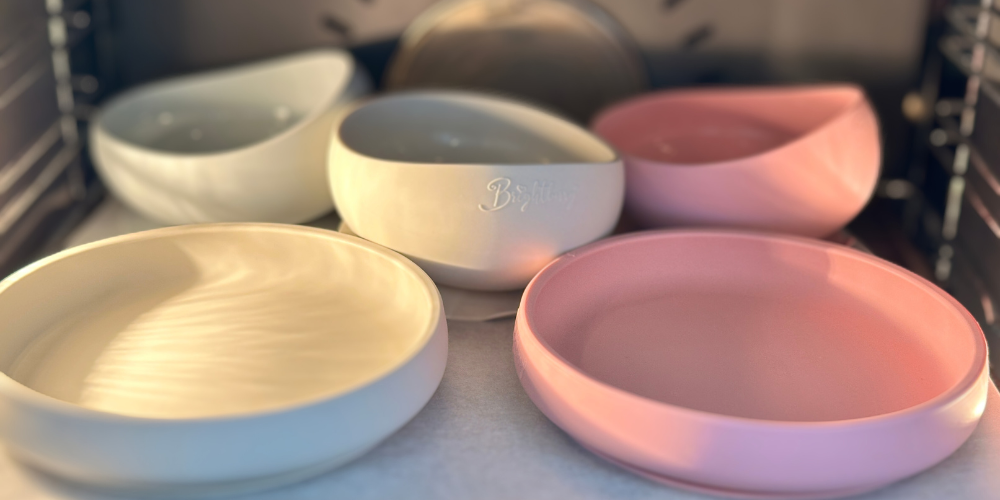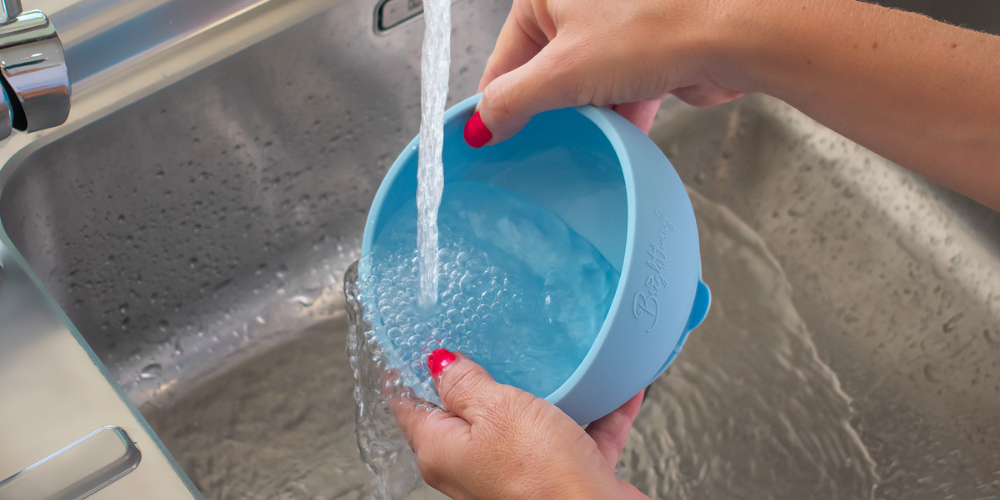3 Effective Ways to Remove Odours from Silicone Tableware
How to Remove Odours from Silicone Tableware: Easy and Safe Methods
Silicone tableware is a fantastic choice for kids, not just because of it's vibrant colours and functional designs, but also for its safety, durability, and easy cleaning. Being unbreakable, resistant to extreme temperatures and free from harmful chemicals, it's no wonder it has become parent's favourite.
However, silicone can sometimes hold on to stubborn odours leaving you wondering how to refresh your little one's feeding essentials. Worry not, because we're here to equip you with three effective methods to eliminate unwanted smells from your silicone tableware and keep your silicone tableware feeling like new, for years to come!
1. Baking Away the Odours

Our top recommendation for odour removal is harnessing the power of heat through baking. This method leverages the science of thermal expansion, where silicone molecules open up when heated, releasing trapped odour molecules and food particles.
Here's how to give your silicone a warm welcome:
1. Preheat your oven: Set your fan-forced oven to 160°C (300-320°F). Remember, never exceed 220°C (428°F) for your silicone safety.
2. Prep your baking sheet: Place your silicone tableware (excluding spoons) on an oven-safe dish or directly on a lined baking sheet.
3. Bake it out: Let the oven work its magic for an hour. This extended time at high temperatures ensures thorough release of even deep-seated odours.
4. Cool down: Carefully remove the hot items using heat-resistant thongs and allow them to cool completely before touching or using.
5. Finishing touches: For a deep clean, wash the silicone with a solution of warm water mixed with baking soda and vinegar. This extra step ensures a thorough refresh.
Note: Due to their reinforced core, silicone spoons are not suitable for baking at high temperatures. Instead, you can safely boil them using the next method.
2. Boiling for Odour Removal

Another effective approach to eliminate odours is through the trusty process of boiling, which also utilises heat expansion. By submerging your silicone in boiling water, the trapped odour molecules and food particles are loosened and released due to the expansion of the silicone pores.
Here's how to remove smell from silicone with boiling water:
1. Get the pot bubbling: Fill a pot with water and bring it to a boil.
2. Submerge your silicone: Carefully place your silicone items using heat-proof thongs (including spoons this time!) in the boiling water, ensuring they are fully submerged.
3. Let it simmer: Boil the products for a few minutes, allowing the trapped odours to escape.
4. Rinse and repeat: Once done, remove the items with tongs and once cooled, wash them with gentle detergent and rinse them with clean water. If the odour persists, repeat the boiling process for a more intense clean.
This method is safe for all Brightberry products, including silicone spoons.
3. Natural Cleaning with Baking Soda and Vinegar or Lemon
If you prefer a natural approach, you can harness the cleaning power of baking soda and vinegar (or lemon) to tackle those pesky odours. This method relies on a chemical reaction between the baking soda and vinegar (or lemon juice), creating a mild alkaline solution that helps neutralise acidic odour molecules.
Here's how remove smells from silicone using baking soda:
1. Create your cleaning paste: Mix equal parts baking soda and vinegar or lemon juice in a bowl to form a paste.
2. Apply the paste: Generously apply the paste to your silicone items, ensuring all surfaces are coated.
3. Let it sit: Allow the paste to work its magic for about five minutes, giving the chemical reaction time to neutralise the odours. For stubborn odours or grease, let the paste dry completely before washing it off. This extended drying time allows for deeper penetration and potentially better cleaning results. However, keep in mind that the dried paste might require more effort to remove during rinsing.
4. Rinse and refresh: Rinse the items thoroughly under hot water to remove the paste and any lingering odours.
Tip: Depending on the thickness of the paste and the environment, "completely dry" might take anywhere from 30 minutes to a few hours.
By following these steps and letting the paste dry for tougher challenges, you can harness the natural cleaning power of baking soda and vinegar (or lemon) to keep your silicone tableware fresh and odour-free!
Choosing the Right Method to Removing Smells from Silicone Tableware: Science as Your Guide
Now that you understand the scientific principles behind each method, choosing the best approach for your needs becomes easier:
Strong, Persistent Odours:
Baking is your champion! The extended heat exposure effectively expands pores, releasing even deeply embedded odour molecules.
Milder Odours or Natural Preference:
Boiling offers a quicker alternative, utilising heat expansion for a decent clean.
Baking Soda & Vinegar/Lemon provides a natural solution, relying on a chemical reaction to neutralise odours. However, its effectiveness may vary depending on the intensity of the smell.
Additional Considerations:
Time commitment: Baking takes longer but offers the most thorough clean. Boiling is quicker but might require repetition for stubborn smells.
Convenience: Boiling or using natural methods might be easier for smaller items or quick clean-ups.
Sensitivity: If you're concerned about heat exposure, boiling for shorter periods or natural methods might be suitable.
Remember:
- Always follow the specific instructions and temperature limits for your chosen method and silicone products.
- After treatment, let the silicone cool completely before touching or using it.
- For an extra clean, wash with warm water and gentle dish soap after any method.
- Store your silicone in a clean, dry place to prevent odour buildup.
By understanding the science behind each method and following these tips, you can make informed choices to keep your silicone tableware fresh and odour-free, ensuring a safe and pleasant dining experience for your little ones.
Beyond the Basics: Extending the Longevity of Your Silicone
For even more valuable insights, explore our next blog post, "How to Best Care for Silicone Tableware." You'll find expert tips on proper cleaning, storage, and usage to maximise the lifespan and performance of your Brightberry silicone products.
Remember, choosing the right approach for odour removal is just one step in ensuring the long-term enjoyment of your silicone tableware. With a little understanding and TLC, your silicone can remain a vibrant and functional partner in your kitchen for years to come!
FAQ Section:
How long should I bake silicone tableware?
To effectively remove odours, you can bake Brightberry silicone items for 1 hour at a temperature of 160°C (300-320°F). However, please avoid baking the spoons as they may not withstand the high temperatures.
Can I boil silicone spoons?
Yes, boiling is safe for silicone spoons for sterilisation and it effectively removes odours.
Can boiling damage my silicone tableware?
No, silicone is heat-resistant and boiling it is a safe method for sterilising or odour removal.
Is it safe to put silicone tableware in the dishwasher?
Yes, Brightberry silicone tableware is designed to be dishwasher safe. For best results, place it on the top rack of your dishwasher. We recommend using a normal wash setting rather than high-temperature settings. High temperatures can sometimes cause silicone to retain odours. This precaution helps ensure your tableware remains odour-free and in top condition.
What should I avoid when cleaning silicone tableware?
Avoid using harsh or heavily scented dish soaps, especially those with essential oils, antibacterial agents, or moisturisers. These can leave a soapy aftertaste on silicone. Also, steer clear of abrasive cleaners or pads to prevent damaging the silicone surface.
Can I use lemon instead of vinegar with baking soda for cleaning silicone tableware?
Yes, lemon juice can be a natural alternative to vinegar for odour removal in your silicone cleaning routine.
If you have any other questions about these methods or need further assistance, please don't hesitate to contact us.












